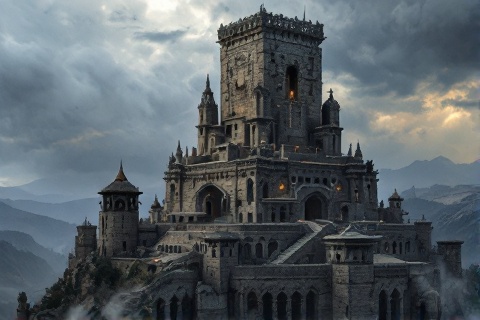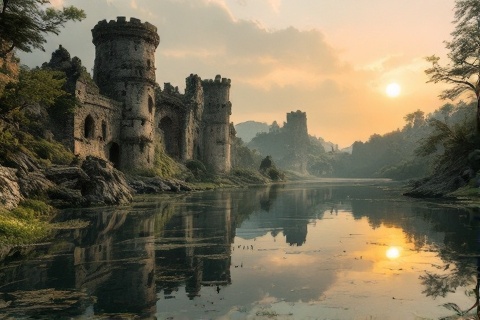
Arnor: The Lost Northern Kingdom of Middle-earth
Rise, Fall, and Legacy of Tolkien's Forgotten Realm
The Foundation of Arnor

In the year 3320 of the Second Age, following the catastrophic downfall of
Númenor, Elendil the Tall established the northern kingdom of
Arnor as a realm in exile. Together with his sons who founded
Gondor in the south, Elendil created this new domain to
preserve the legacy and culture of the Númenóreans who had remained faithful to
the Valar. As his first great undertaking in this new land,
Elendil founded the majestic capital city of Annúminas on the serene shores of
Lake Evendim, known to the Elves as Nenuial. The city became a
symbol of Númenórean craftsmanship and glory in
Middle-earth.
Annúminas, situated on the southeastern shores of Lake Evendim, quickly grew
into a magnificent city that rivaled the splendor of Númenórean cities of old.
Within its walls, Elendil established his throne and housed many of the
treasures brought from Númenor, including the palantír of
the North and various heirlooms of his house. The city's architecture reflected
the height of Númenórean craftsmanship, with its white towers and great halls
overlooking the pristine waters of the lake.
The kingdom of Arnor encompassed vast territories between the Misty Mountains in
the east and the Blue Mountains (Ered Luin) in the west. This expansive realm
included the regions that would later become Eriador, stretching from the Ice
Bay of Forochel in the north to the river Gwathló (Greyflood) in the south. The
kingdom's strategic position allowed it to maintain contact with the Elven
havens of Lindon and the realm of Khazad-dûm, establishing
important diplomatic and trade relationships that would prove vital in the years
to come.
Geography and Landscapes

The territory of Arnor was divided into three principal regions, each with its
own distinct character and importance to the kingdom. Arthedain in the northwest
became the most populous and culturally significant region, containing both
Annúminas and later Fornost. Cardolan, the central region, was known for its
rich farmlands and strategic position along the Great East Road, while Rhudaur
in the northeast was the most wild and mountainous of the three, bordered by the
Misty Mountains and the Ettenmoors.
Natural boundaries provided Arnor with formidable defenses against external
threats. The Misty Mountains served as an imposing eastern barrier, while the
Gwathló River marked its southern border with Enedwaith. The Ice Bay of Forochel
and the North Downs created natural fortifications to the north, though the
harsh climate of the northern wastes posed its own challenges to the kingdom's
expansion.
Among the most notable geographical features of Arnor were the Weather Hills,
which formed a natural barrier in the eastern portion of the realm and would
later become strategically crucial during times of conflict. The Great East
Road, originally built by the Dwarves but improved and maintained by the
Dúnedain, served as the kingdom's primary transportation artery, connecting the
Grey Havens in the west to the Misty Mountains and beyond, facilitating trade
and communication throughout the realm.
Architecture and Fortifications

The Tower of Amon Sûl, built upon the tallest of the Weather Hills, stood as one
of the most impressive structures in all of Arnor. This mighty watchtower housed
one of the kingdom's three palantíri and served as a crucial defensive position
and communication center. The North Downs fortifications complemented Amon Sûl's
defensive network, creating a strong line of protection for the kingdom's
heartland while providing excellent vantage points for monitoring movement
across the realm.
The cities of Arnor displayed the distinctive architectural style of the
Númenóreans, characterized by tall towers, massive stone walls, and intricate
craftmanship that would endure for thousands of years. These fortified
settlements incorporated advanced engineering techniques brought from Númenor,
including sophisticated water management systems and defensive innovations that
would influence the building practices of lesser men throughout the Third
Age.
An elaborate network of beacons and defensive structures lined the major routes
throughout Arnor, allowing for rapid communication and response to threats.
These installations included signal towers, garrison posts, and way stations
that helped maintain the kingdom's internal security and communication system.
The placement of these structures demonstrated the strategic wisdom of the
Dúnedain, as they were positioned to maximize visibility and defensive advantage
while facilitating swift movement of troops and messengers throughout the realm.
Realm of the Dúnedain

The noble houses of the Númenóreans established numerous settlements throughout
Arnor, creating centers of culture and power that reflected their ancient
heritage. These strongholds served as seats of governance for the various
regions of the kingdom, where noble families maintained their own courts and
contributed to the overall administration of the realm. The nobles played a
crucial role in maintaining the kingdom's military strength and cultural
identity, training their sons in both warfare and lore.
Arnor's settlements became renowned as centers of learning where the wisdom and
knowledge of Númenor were preserved and studied. The libraries of Annúminas and
later Fornost contained countless scrolls and books, recording histories,
genealogies, and the accumulated knowledge of the Dúnedain. Scholars worked
diligently to maintain records of both their ancient homeland and their new
realm, ensuring that the wisdom of their forebears would not be lost to time.
The Dúnedain of Arnor maintained many of the ancient traditions and customs of
Númenor, including the use of Quenya for ceremonial purposes and the
preservation of artifacts from their homeland. They continued to observe the old
calendar systems and maintained their traditional forms of governance and social
structure. The kings of Arnor kept detailed annals of their realm and maintained
diplomatic relations with the Elves, preserving the alliance that had existed
since the days of the Last Alliance.
The Northern Wilderness

Between the settled regions of Arnor lay vast tracts of wild lands that remained
largely untamed throughout the kingdom's existence. These areas served as
hunting grounds for the nobility and provided natural resources for the realm,
but they also harbored various dangers including wolves, trolls, and other fell
creatures that would occasionally threaten the populated regions. The wild lands
also contained numerous ruins from earlier ages, remnants of the kingdoms of
Men and Elves who had inhabited these regions in the First and
Second Ages.
The Barrow-downs, known in Sindarin as Tyrn Gorthad, stood as silent testimonies
to the ancient history of the region. These burial grounds contained the tombs
of the kings of Arnor and other noble houses, as well as even older burials from
the First Age. The barrows were carefully tended and honored
during the kingdom's height, though they would later become places of dread
after evil spirits took residence in them following the kingdom's fall.
The forests and hills of Arnor encompassed various landscapes, from the dense
woodlands near the Brandywine River to the rolling hills of the North Downs.
These areas supported diverse wildlife and provided valuable resources for the
kingdom's economy. The Old Forest on the kingdom's eastern borders remained a
mysterious and somewhat dangerous region, home to ancient trees and strange
powers that predated the arrival of the Númenóreans.
Remnants and Ruins

The ruins of Annúminas by Lake Evendim stand as a poignant reminder of Arnor's
former glory. Though largely abandoned by the Third Age, the remaining
structures showcase the impressive architectural achievements of the
Númenóreans. The broken towers and weathered walls still retain traces of their
former majesty, with intricate stonework and massive foundations that have
withstood the passage of thousands of years.
Throughout the former territories of Arnor, scattered remains of ancient
settlements can still be found, from isolated towers to the foundations of
once-mighty fortresses. These ruins often contain fragments of sophisticated
engineering works, including roads, bridges, and water management systems that
demonstrate the advanced technological capabilities of the Dúnedain. Many of
these sites became points of interest for the Rangers of the North, who
maintained watch over these remnants of their ancestors' realm.
Despite the kingdom's fall, numerous artifacts and monuments survived to
preserve the memory of Arnor's greatness. These include stone markers, boundary
posts, and ceremonial sites that dot the landscape of Eriador. The most
significant preserved artifacts include the royal heirlooms of Arnor, such as
the Sceptre of Annúminas and the shards of Narsil, which
were carefully protected by the chieftains of the Dúnedain through the ages
until the time of Aragorn's return as king.
